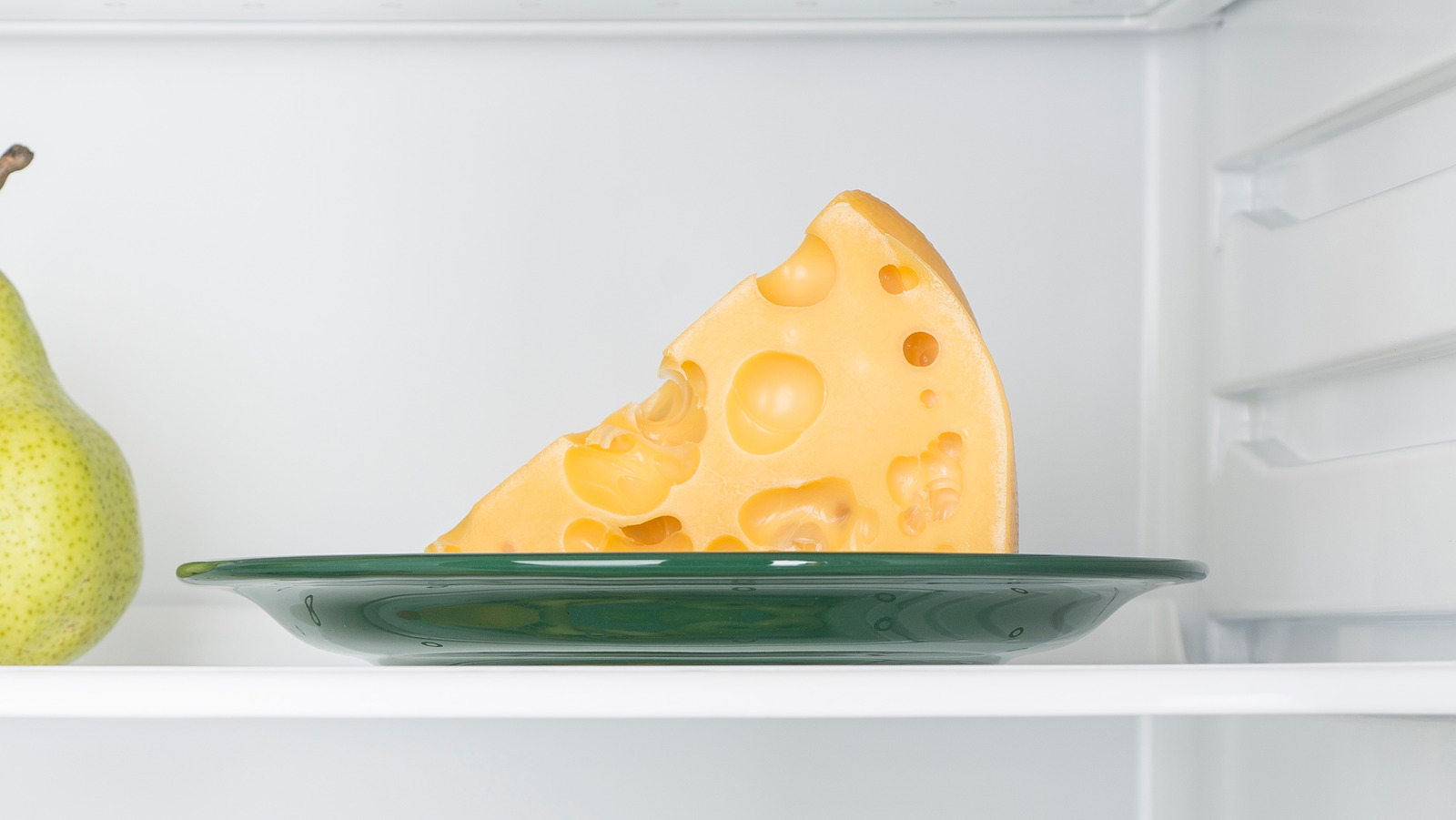

Articles
How To Store Block Of Parmesan Cheese
Modified: February 23, 2024
Learn the best techniques for storing a block of Parmesan cheese in this informative article. Keep your cheese fresh and delicious for longer with these helpful tips.
(Many of the links in this article redirect to a specific reviewed product. Your purchase of these products through affiliate links helps to generate commission for Storables.com, at no extra cost. Learn more)
Introduction
Parmesan cheese is a versatile and delicious ingredient that adds a flavorful punch to various dishes. Whether you use it to top off a plate of pasta, grate it onto a salad, or enjoy it on its own, storing your block of Parmesan cheese properly is essential to maintain its quality and flavor.
In this article, we will guide you through the process of storing a block of Parmesan cheese to ensure its longevity and taste. We will cover everything, from choosing the right block of cheese to selecting the optimal storage method. So, if you want to prevent your Parmesan cheese from going bad and maximize its lifespan, keep reading!
Key Takeaways:
- Choose high-quality, grainy Parmesan cheese from Italy for optimal flavor. Prepare, wrap, and store it properly to maintain freshness and enjoy its rich, nutty taste in various dishes.
- Whether at room temperature, in the refrigerator, or freezer, follow proper storage techniques to prolong the shelf life of Parmesan cheese. Use it creatively to enhance pasta, salads, sauces, and more for delightful culinary experiences.
Read more: How To Store Parmesan Cheese Block
Choosing the Right Block of Parmesan Cheese
When it comes to selecting a block of Parmesan cheese for storage, it is important to choose a high-quality cheese to ensure the best flavor and texture. Here are a few things to consider when making your selection:
- Age: Parmesan cheese comes in different aging options, ranging from young to extra-aged. The aging process significantly affects the flavor and texture of the cheese. Younger Parmesan cheese tends to be milder and softer, while extra-aged Parmesan cheese develops a sharper and more robust flavor. Choose the age of the cheese based on your personal preference and the intended use.
- Graininess: Look for Parmesan cheese with a granular texture. This graininess is a sign of high-quality cheese and indicates that it has been aged properly.
- Origin: Consider the region of origin when selecting your Parmesan cheese. Parmigiano-Reggiano, made in Italy, is known as the true and authentic Parmesan cheese. It is produced using traditional methods and offers exceptional quality and flavor.
- Whole Wheels or Partial Wheels: You can choose to buy a whole wheel or a portion of a wheel, depending on your needs. Buying a whole wheel allows you to portion and store the cheese as needed, while a partial wheel is a convenient option if you don’t require a large quantity.
- Check for Authenticity: Look for the Parmigiano-Reggiano stamp on the rind to ensure that you are purchasing genuine Parmesan cheese. This stamp guarantees that the cheese has been made following strict regulations and meets the highest quality standards.
By considering these factors, you can select a high-quality block of Parmesan cheese that will provide exceptional flavor and withstand proper storage.
Preparing the Cheese for Storage
Before you store your block of Parmesan cheese, it is important to properly prepare it to ensure its longevity and quality. Here are the steps to follow:
- Remove any Packaging: Take your block of Parmesan cheese out of its original packaging. This is typically a plastic wrap or a vacuum-sealed bag. Removing the packaging allows the cheese to breathe and prevents moisture buildup.
- Inspect the Cheese: Examine the cheese to ensure that it is free from any mold or visible defects. If you notice any mold or off-putting smells, it is best to discard the cheese instead of storing it.
- Cut the Cheese: If you have purchased a large block of Parmesan cheese, you may want to cut it into smaller portions before storing. Dividing the cheese into manageable sizes will make it easier to access and use later on.
- Label the Cheese: If you are storing different varieties of Parmesan cheese or have cut the cheese into different sizes, it is wise to label each portion with the type and date of purchase. This will help you keep track of the cheese and its freshness.
- Optional: Grate or Shred: Depending on your preference and intended use, you may choose to grate or shred some or all of the Parmesan cheese before storage. This can be helpful if you frequently use grated cheese in your recipes and want to save time later on.
By following these preparation steps, you will ensure that your Parmesan cheese is ready for storage, maintaining its quality and making it convenient to use in your culinary creations.
Wrapping the Parmesan Cheese
Properly wrapping your Parmesan cheese is crucial for preserving its flavor and preventing it from drying out or absorbing odors from the surrounding environment. Here are some tips for effectively wrapping your Parmesan cheese:
- Choose the Right Wrapping Material: Opt for materials that are moisture-resistant and airtight. The most common choices are wax paper, parchment paper, aluminum foil, or cheese paper. Avoid using plastic wrap as it can trap moisture and lead to mold growth.
- Wrap the Cheese Tightly: Begin by placing the block of Parmesan cheese in the center of the chosen wrapping material. Fold the material around the cheese, ensuring it is tightly sealed on all sides. This will help keep moisture out and prevent the cheese from drying out.
- Secure with Tape or Rubber Bands: To further protect the cheese and maintain its shape, you can use tape or rubber bands to secure the wrapping material. This will ensure that the cheese remains tightly packed and avoids any exposure to air.
- Label the Wrapped Cheese: If you have multiple wrapped blocks of Parmesan cheese or different aging varieties, labeling each package can make it easier to identify and use later on. Include the date of wrapping for reference.
- Consider Vacuum-Sealing: For long-term storage, vacuum-sealing the wrapped Parmesan cheese can be an excellent option. This method removes air from the package, minimizing the risk of oxidation and prolonging the cheese’s shelf life.
Remember to wrap each individual block or portion of Parmesan cheese separately, especially if you have cut it into smaller sizes. This way, you can easily access and use only what you need without exposing the rest of the cheese to air and potential spoilage.
By following these wrapping techniques, you will ensure that your Parmesan cheese stays fresh and retains its delicious flavor for an extended period.
Selecting the Storage Method
Choosing the right storage method for your Parmesan cheese is essential to maximize its shelf life and maintain its quality. The ideal storage method can vary depending on the temperature, humidity, and available space in your kitchen. Here are three common storage options to consider:
- Room Temperature: If you plan to use your Parmesan cheese within a relatively short period, storing it at room temperature can be a viable option. This is particularly suitable if you live in a cool and dry environment. However, keep in mind that Parmesan cheese stored at room temperature tends to age and develop a stronger flavor faster. It is crucial to monitor the cheese regularly for any signs of spoilage.
- Refrigerator: Storing Parmesan cheese in the refrigerator is a popular choice for extending its shelf life while retaining its quality. Wrap the cheese tightly in the appropriate wrapping material and place it in an airtight container or a resealable plastic bag to minimize moisture absorption and prevent odors from other foods. The refrigerator’s cool temperature helps slow down the cheese’s aging process and keeps it fresh for a more extended period. However, note that refrigeration can slightly affect the texture of the cheese, making it harder. It is best to remove the cheese from the refrigerator a few minutes before using it to allow it to soften slightly.
- Freezer: If you want to store Parmesan cheese for an extended period, the freezer is the most suitable option. Freezing Parmesan cheese can keep it fresh for up to six months or longer. Wrap the cheese tightly in multiple layers of wrapping material to prevent freezer burn and place it in a freezer-safe bag or container. Before using the frozen cheese, thaw it in the refrigerator overnight. While the texture may become slightly crumbly after freezing, the flavor will remain intact.
Consider your usage pattern, available storage space, and desired freshness when choosing the storage method for your Parmesan cheese. Remember to label each storage container with the date to keep track of the cheese’s expiration and ensure optimal quality.
By selecting the appropriate storage method, you can prolong the shelf life of your Parmesan cheese and enjoy its delicious flavor in various dishes.
Read more: How To Store A Block Of Parmesan Cheese
Storing Parmesan Cheese at Room Temperature
Storing Parmesan cheese at room temperature can be an option if you plan to use it within a relatively short period. However, it is essential to take certain precautions to ensure its freshness and prevent spoilage. Here are some guidelines for storing Parmesan cheese at room temperature:
- Choose a Cool and Dry Area: Find a cool spot in your kitchen that is away from direct sunlight and heat sources. Avoid areas with high humidity, as moisture can lead to mold growth.
- Wrap the Cheese Properly: Wrap the Parmesan cheese tightly in wax paper, parchment paper, or cheese paper to protect it from air and moisture. Make sure the wrapping material seals the cheese completely and prevents any exposure to external elements.
- Store in an Airtight Container: Place the wrapped Parmesan cheese in an airtight container to provide an additional layer of protection and maintain its freshness. This will also help prevent the cheese from absorbing any odors from other foods in the surrounding environment.
- Regularly Inspect the Cheese: Check the Parmesan cheese periodically for any signs of mold or spoilage. If you notice any discoloration, foul smell, or visible mold growth, discard the cheese immediately.
It is important to note that Parmesan cheese stored at room temperature tends to age and develop a stronger flavor faster compared to refrigerated or frozen cheese. Therefore, it is recommended to use it within a few weeks for optimal taste and quality.
Remember to handle the cheese with clean hands or utensils to prevent contamination and maintain its hygiene. Additionally, keep the area around the stored Parmesan cheese clean to minimize the risk of any cross-contamination.
By following these guidelines, you can safely store Parmesan cheese at room temperature and enjoy its distinctive flavor and texture while keeping it fresh for a reasonable period.
Store a block of Parmesan cheese in the refrigerator in an airtight container or wrapped tightly in plastic wrap to prevent it from drying out. It can also be stored in the freezer for longer periods.
Storing Parmesan Cheese in the Refrigerator
Storing Parmesan cheese in the refrigerator is a popular choice to extend its shelf life while preserving its quality. The cold temperature of the refrigerator helps slow down the aging process and maintains the cheese’s freshness. Here are some steps to follow when storing Parmesan cheese in the refrigerator:
- Wrap the Cheese: Wrap the Parmesan cheese tightly in wax paper, parchment paper, aluminum foil, or cheese paper. This will protect the cheese from air exposure and prevent excess moisture absorption.
- Seal in an Airtight Container: After wrapping the cheese, place it in an airtight container or a resealable plastic bag. This will provide an additional layer of protection and prevent the cheese from picking up any odors from other foods in the refrigerator.
- Choose the Right Shelf: Place the wrapped Parmesan cheese on one of the refrigerator’s colder shelves, away from the vents or areas that experience temperature fluctuations. This will help maintain a consistent temperature and minimize the risk of the cheese drying out.
- Regularly Check for Spoilage: Periodically inspect the Parmesan cheese for any signs of mold or spoilage. If you notice any discoloration, an off smell, or visible mold growth, discard the cheese immediately.
- Use within a Reasonable Timeframe: While Parmesan cheese can be stored in the refrigerator for an extended period, it is best to use it within a few months for optimal flavor and quality. The cheese may become slightly harder in texture when refrigerated, so allow it to soften for a few minutes at room temperature before using.
Remember to keep the refrigerator clean and organized to prevent any potential cross-contamination with other foods. Labeling the container or wrapping with the purchase date can be helpful to track the cheese’s freshness.
Following these steps will help you store Parmesan cheese in the refrigerator correctly, ensuring it stays fresh and ready to enhance your recipes with its distinct savory flavor.
Storing Parmesan Cheese in the Freezer
If you want to store Parmesan cheese for an extended period, the freezer is an excellent option. Freezing Parmesan cheese can help preserve its freshness and flavor for up to six months or longer. Here’s how to store Parmesan cheese in the freezer:
- Wrap the Cheese Properly: Start by tightly wrapping the Parmesan cheese in multiple layers of wax paper, parchment paper, aluminum foil, or cheese paper. This will protect the cheese from freezer burn and prevent moisture loss.
- Place in a Freezer-Safe Bag or Container: Once wrapped, put the Parmesan cheese in a freezer-safe bag or airtight container. Make sure the container is properly sealed to prevent air from entering and freezer odors from affecting the cheese.
- Label and Date the Package: Use a permanent marker to label the container or bag with the type of cheese and the date of storage. This will help you keep track of the cheese and ensure you use the oldest package first.
- Store in the Freezer: Place the wrapped Parmesan cheese in the freezer. Try to position it away from areas where it may get crushed or damaged. It is also a good idea to keep it in a spot where it is less likely to be exposed to temperature fluctuations.
- Thawing and Using Frozen Cheese: When you’re ready to use the frozen Parmesan cheese, transfer it to the refrigerator and let it thaw overnight. This gradual thawing in the fridge will help preserve its texture and flavor. After thawing, use the cheese within a reasonable time frame for the best taste.
While frozen Parmesan cheese may become slightly crumbly after thawing, its flavor will remain intact. Remember to only thaw the amount of cheese you need and return the rest to the freezer promptly.
By following these steps, you can store Parmesan cheese in the freezer and have a readily available supply of high-quality cheese for your favorite recipes.
Maintaining the Quality of Stored Parmesan Cheese
To ensure the longevity and quality of stored Parmesan cheese, it is important to follow certain guidelines and practices. Here are some tips for maintaining the quality of your stored Parmesan cheese:
- Proper Storage Conditions: Whether you store Parmesan cheese at room temperature, in the refrigerator, or freezer, it is crucial to maintain suitable storage conditions. Keep the cheese in a cool and dry place, away from direct sunlight, heat sources, and areas with high humidity.
- Regular Inspection: Check the Parmesan cheese regularly for any signs of spoilage. Look for changes in color, texture, and smell. If you notice any discoloration, a foul odor, or visible mold growth, discard the cheese immediately.
- Prevent Cross-Contamination: Store Parmesan cheese in separate containers or wrap them individually to prevent cross-contamination with other foods in the refrigerator or freezer. This will help maintain the cheese’s distinct flavor and prevent the absorption of unwanted odors.
- Avoid Condensation: Condensation can lead to moisture buildup, which can promote mold growth and affect the quality of the cheese. To prevent condensation, allow the cheese to reach room temperature before wrapping it and avoid sudden temperature changes, such as taking the cheese directly from the refrigerator to room temperature.
- Use Clean Utensils: When handling stored Parmesan cheese, use clean utensils or clean hands to avoid introducing bacteria or contaminants. This will help maintain the cheese’s cleanliness and prevent unwanted spoilage.
- Rotate and Use in Order: If you have multiple portions or packages of Parmesan cheese, make sure to rotate their use in order. Use the oldest cheese first to prevent any cheese from going bad and to enjoy the freshest flavor.
- Avoid Freezing and Thawing Multiple Times: Repeated freezing and thawing can affect the texture and quality of Parmesan cheese. To maintain the best texture and flavor, try to freeze the cheese only once and avoid thawing and refreezing multiple times.
- Properly Re-Seal Packages: After each use of the Parmesan cheese, make sure to reseal the packaging tightly to prevent air exposure. This will help preserve the cheese’s freshness and prevent it from drying out.
By following these practices, you can prolong the shelf life and maintain the quality of stored Parmesan cheese, ensuring it remains a delicious addition to your culinary creations.
Read more: How To Store Fresh Parmesan Cheese
Tips for Using Stored Parmesan Cheese
Stored Parmesan cheese can be a convenient ingredient to have on hand for various recipes. Here are some tips to make the most out of your stored Parmesan cheese:
- Grate as Needed: If you stored the Parmesan cheese in a block, grate or shred it as needed. This ensures maximum freshness and flavor, as grated cheese tends to lose its flavor more quickly than whole blocks.
- Enhance Pasta Dishes: Parmesan cheese is commonly used as a topping for pasta dishes. Grate some fresh Parmesan over your favorite pasta recipes to add a rich and savory flavor. The cheese will melt and create a creamy and delicious sauce.
- Upgrade Salads: Sprinkle grated or shaved Parmesan cheese over your salads to elevate their taste. The salty, nutty flavor of Parmesan complements various greens and adds a satisfying bite to your salad.
- Pairs Well with Fruits: Try pairing Parmesan cheese with fruits such as pears, apples, or even strawberries. The combination of sweet and savory flavors creates a delightful contrast that is sure to impress your taste buds.
- Use in Sandwiches or Wraps: Add sliced or grated Parmesan cheese to your sandwiches or wraps for an extra burst of flavor. It works well with a variety of ingredients, such as cured meats, roasted vegetables, or fresh herbs.
- Create Parmesan Crisps: Turn your Parmesan cheese into crispy and flavorful treats by baking small mounds of grated cheese until golden and bubbly. These Parmesan crisps can be enjoyed as a snack on their own or used to garnish salads and soups.
- Experiment with Parmesan-Based Sauces: Use Parmesan cheese as the base for homemade sauces, such as Alfredo or carbonara. Its creamy texture and robust flavor elevate the sauce to new heights of deliciousness.
- Explore New Recipes: Don’t hesitate to try new recipes that feature Parmesan cheese as a star ingredient. From hearty risottos to delightful Parmesan breadsticks, there are countless ways to showcase the versatility of this cheese.
- Grate and Preserve the Rinds: Don’t discard the rinds of your Parmesan cheese blocks! Grate or chop them and use them to infuse flavor into soups, stews, and sauces. The rinds add a depth of taste that enhances the overall dish.
- Experiment with Cheese Pairings: Pair your Parmesan cheese with other cheeses for a cheeseboard or a delightful cheese platter. Combine it with milder cheeses like Brie or Gouda to create a balanced and flavorful experience.
Remember, the key to using stored Parmesan cheese is to unleash your creativity and explore different ways to incorporate its rich flavor into your favorite dishes. Enjoy the deliciousness that this versatile cheese brings to your culinary creations!
Conclusion
Properly storing Parmesan cheese is crucial for maintaining its freshness, flavor, and texture. Whether you choose to store it at room temperature, in the refrigerator, or in the freezer, following the right techniques and practices will help extend its shelf life and ensure its quality. By choosing the right block of Parmesan cheese, preparing it for storage, wrapping it properly, and selecting the suitable storage method, you can enjoy the deliciousness of Parmesan cheese for a longer period.
Remember to regularly inspect the cheese for any signs of spoilage and use clean utensils when handling it to maintain its hygiene. Properly labeling and dating the cheese packages will help you keep track of their freshness and usage order. Additionally, following the tips for using stored Parmesan cheese will elevate your culinary creations and bring out the best flavors in your dishes.
Whether grated over pasta, added to salads, or incorporated into various recipes, Parmesan cheese adds a delightful, savory note to any dish. By taking the time to store Parmesan cheese correctly and following these tips, you can ensure that you always have a delicious supply of Parmesan cheese on hand to enhance your favorite recipes.
So, the next time you bring home a block of Parmesan cheese, remember to store it properly and explore the multitude of flavors that this versatile cheese has to offer. Enjoy the rich, nutty taste of Parmesan cheese and elevate your culinary creations to new heights!
Frequently Asked Questions about How To Store Block Of Parmesan Cheese
Was this page helpful?
At Storables.com, we guarantee accurate and reliable information. Our content, validated by Expert Board Contributors, is crafted following stringent Editorial Policies. We're committed to providing you with well-researched, expert-backed insights for all your informational needs.














0 thoughts on “How To Store Block Of Parmesan Cheese”